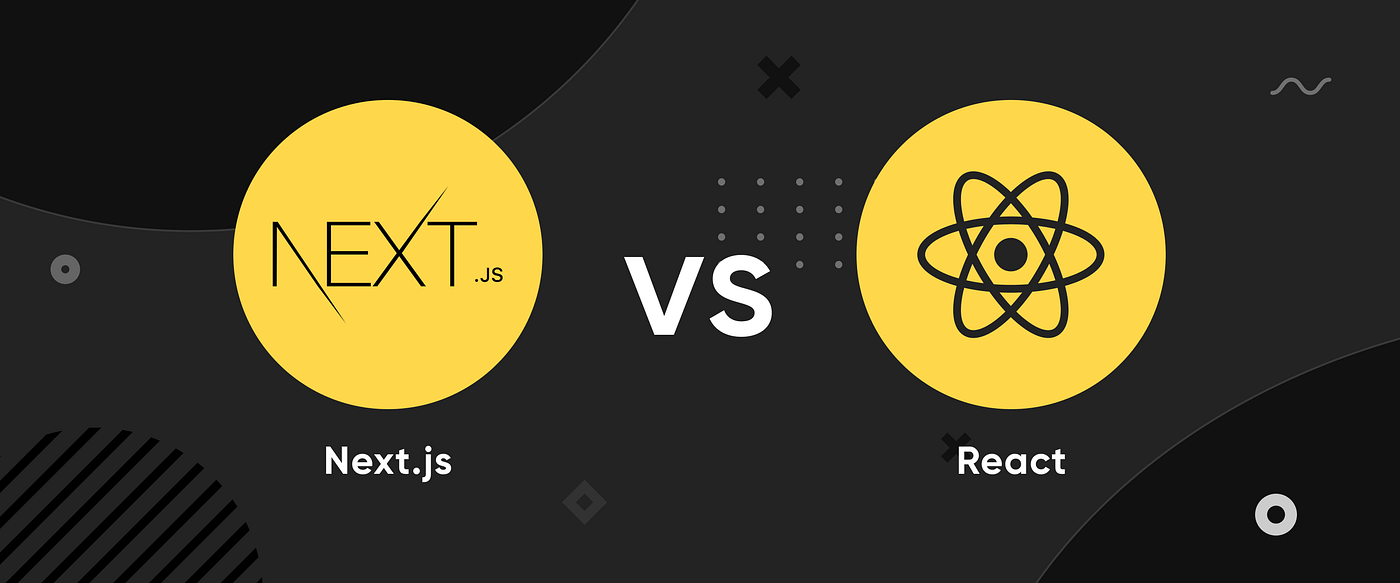Contents
- Introduction
- What is Next.js?
- What is React?
- Difference Between React and Next.js
- Advantages and Disadvantages of Next.js and React
- Is Next.js Better Than React?
- Should I Learn Next.js or React?
Introduction
React.js has been a dominant force in web development for years. More recently, Next.js has emerged as a powerful framework built on top of React, offering additional features and optimizations. This article explores the key differences and use cases for these two popular technologies.

What is Next.js?
Next.js is a React framework used to build high-quality web applications. It’s popular among major companies due to its powerful features.

Key Features of Next.js:
- File-System Based Routing: Create routes by simply adding files to the pages directory. This supports layouts, nested routing, loading states, and error handling.
- Rendering Options: Supports both client-side and server-side rendering, with additional optimizations for static and dynamic rendering. UI streaming from the server is also supported via Edge and Node.js runtimes.
- Data Fetching: Simplified data fetching with async/await in server components and an extended fetch API for caching, revalidation, and request memoization.
- Styling: Supports multiple styling options, including CSS modules, Tailwind CSS, and CSS-in-JS.
- Optimizations: Automatic optimizations for images, fonts, and scripts, improving Core Web Vitals and user experience.
- TypeScript Support: Provides enhanced TypeScript support with better type checking and efficient compilation, along with a custom TypeScript plugin.
- API Routes: Built-in API endpoints for securely connecting to third-party services, handling authentication, or listening for webhooks.
- Incremental Static Regeneration (ISR): Update static content without rebuilding the entire site.
- Fast Refresh: Instant feedback on edits made to your React components, enhancing the development experience.
- Next.js Compiler: Written in Rust, it transforms and minifies your Next.js application for better performance.
What is React?
React is a popular JavaScript library for building user interfaces, especially for single-page applications where performance and interactivity are key.

Key Features of React:
- JSX (JavaScript XML): Allows developers to write HTML-like code inside JavaScript, making it easier to understand and maintain. You can also use TypeScript with React.
- Virtual DOM: React’s virtual DOM enhances performance by updating only the parts of the DOM that need changes, instead of reloading the entire page.
- Components: React is built on reusable components, which can be either class-based or functional.
- One-Way Data Binding: Follows a unidirectional data flow, making data changes easier to track and debug.
- React Hooks: Hooks allow you to use state and other React features in functional components, promoting cleaner, more manageable code.
- Performance: React’s virtual DOM and efficient diffing algorithms ensure smooth user experiences.
- Flexibility: React can be used for both web and mobile applications, thanks to React Native.
- Community and Ecosystem: React has a large, active community and an extensive ecosystem of libraries and tools.
Difference Between React and Next.js
| Feature | React | Next.js |
|---|---|---|
| Type | JavaScript library | React framework |
| Routing | Requires additional libraries | Built-in file-system-based routing |
| Rendering | Client-side by default | Supports both client- and server-side |
| SEO | Requires extra setup | Better SEO support out of the box |
| Performance | Good, but needs manual optimizations | Built-in performance optimizations |
| Learning Curve | Steeper for beginners | Easier for beginners |
| API Routes | Requires separate backend setup | Built-in API routes |
| Static Site Generation | Requires additional tools | Built-in static site generation |
| Code Splitting | Manual configuration needed | Automatic code splitting |
| TypeScript Support | Requires extra setup | Built-in TypeScript support |
Is Next.js Better Than React?
Whether Next.js is “better” than React depends on your project requirements. Next.js offers features like server-side rendering, automatic code splitting, and simplified routing, which enhance performance and developer experience. For smaller or simpler projects, React alone may be sufficient. Ultimately, Next.js extends React, providing a more opinionated framework that can accelerate development for specific types of applications, especially those that benefit from server-side rendering and improved SEO.
Should I Learn Next.js or React?
The decision between learning Next.js or React depends on what you want to build:
- Next.js: Best for projects requiring server-side rendering, static site generation, or simplified routing. If you already know React, learning Next.js will be easier.
- React: Ideal if you want more flexibility or are building a simpler project. Knowledge of HTML, CSS, and JavaScript will help you quickly pick up React.
Both React.js and Next.js are powerful tools in web development. Your choice should be based on your project’s specific needs. Each has its own strengths, and selecting the right one depends on your use case and team requirements.



